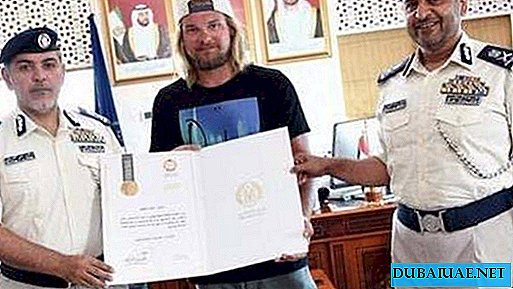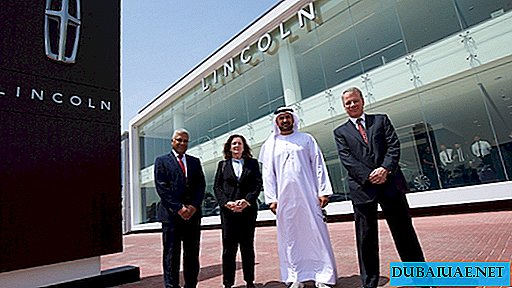The Khalid Lagoon embankment in Sharjah turned into a colorful booth: along the coast, temporary wooden and celluloid structures stretched. These are stands and awnings for spectators and teams from all over the world who have specially gathered here in the Emirates for the seventh time to take part in the F-1 world championship in water-motor racing.
The World Championship in water-motor sports was conceived as an analogue of automotive Formula 1. The history of racing dates back to 1962, when two enthusiasts - Molinari and Schulz - assembled the first sports catamarans. But officially the first championship was held only after 19 years - in 1981.

Water Formula 1 is an amazingly beautiful sight: bright sports catamarans seem to fly above the water, raising fountains of spray on steep bends and driving a foamy wave to the shore. But these are all emotions, and the dry facts suggest that the methods of organizing competitions and training riders, overload, pressure and speed are almost identical to car races in the same class. And the risk of accidents on water is also high, because a catamaran at a speed of more than 180 km / h becomes extremely unstable and, with the slightest wave of water, it can make a somersault in the air and hit the water with a force identical to the force of impact on a concrete wall. So in October 2001, in a terrible accident at the World Cup in the UAE, the Russian racer Viktor Kunich, who played for the Latvian team, was killed. Therefore, the security requirements are very stringent, and the selection of participants is extremely serious. Formula 1 races are allowed only for extra-class pilots who have the super license of the International Water-Motor Union (UIM). To obtain such a license, it is necessary to go through the stages of ten or more races of the highest world level on ships of the lower grades, for example, in the Formula-3 class, where the engine capacity does not exceed 850 cc.
The approach to the discipline at competitions of this level is also very serious: the rider must arrive at the stage no later than at 15.00 a day before the start of the training races. In case of any delay, even regarding non-flying weather, a driver is not allowed to drive. It is logical, because the pilot needs to be well rested for the start.
Throughout their careers, riders regularly pass the turtle test, the so-called "tortoise test", the meaning of which is to ensure that the pilot is constantly in full "combat" readiness and does not lose the skills to leave the overturned catamaran. During training, the vessel with the pilot in the cockpit (car cockpit) is turned over on the water, the judge with a stopwatch records the time and watches the athlete. As practice has shown, with a real overkill, when one's own life depends on the speed and clarity of actions, the pilot usually jumps to the surface much faster than on the exam.
Traditionally, Formula 1 races are held as follows: the water area of Khalid Laguna around the island is marked with three or four turning buoys so that the length of each straight section of the route is no more than 850 m (this figure is accepted in all competitions of this kind for safety reasons, so that the riders do not reach to maximum speed on the track). The total length of the waterway is usually 2011 m.
According to the adopted rules, new participants will start 5 seconds after the recognized favorites. The most advantageous positions at the start are six boats that have shown the best results in qualifying races.
The main stage of the race lasts about 45 minutes, and the winner of the competition is the one who first passed the set number of laps. After the finish of the first, the rest reach the end of the lap. The places of the remaining participants are determined by the number of complete laps completed or the sequence of passing the finish line. Earned points are summed up according to the results at all stages of the championship.

The highest class water racers have common technical characteristics. The modern planing racing catamaran is equipped with an outboard motor and is designed for movement in a mode called near-screen flight (when sliding above water at full speed in the water there are only a screw and aft part of the bottom). The vessel is 6 m long and 2.1 m wide. The hull is made of carbon fiber reinforced with Kevlar, titanium alloys and special marine plywood. The pilot of the car is in the cockpit, closed in an aviation manner with a cap of high-strength glass. The steering wheel is removable, for the convenience of landing and disembarking the pilot. The turns of the engine are facilitated by cables that are pulled from the cockpit to the stern through a system of roller blocks, and using a special hydraulic device you can change the angle of inclination of the engine axis ("tilt angle") and thereby put the propeller in the most favorable position, which makes it possible to maximize developed power. The cars are mounted Mercury outboard engines with a volume of 2 liters and a capacity of 380 liters. with.
The fuel tank capacity is designed for 110 liters, the engines run on aviation gasoline with the addition of 2% of special racing oil, any other fuel is prohibited.
The gross weight of the scooter is 390 kg, the permissible maximum speed is 220 km / h, but in the absence of wind, waves and oncoming currents, sports catamarans can reach speeds of up to 240 km / h. Acceleration to 100 km / h from the moment of starting the engine is 4 seconds.
With a sharp set of speeds, the rider experiences overloads comparable to the overloads of aerobatics.
Racing car racing at all capacities, the roar of engines, the enthusiastic cries of the audience, the joyful faces of the winners - water competitions have become a real celebration for guests and residents of Sharjah. The organizers and sponsors of the World Championship Formula 1 Sharjah Grand Prix approached with all responsibility to hold a vivid and memorable event and did everything to make it memorable for a long time.
Elena Balina









